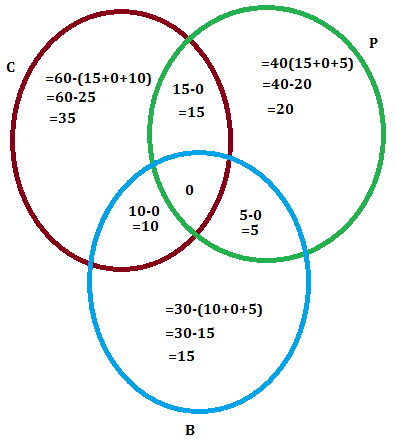
In a college, 60 students enrolled in chemistry, 40 in physics, 30 in biology, 15 in chemistry and physics, 10 in physics and biology, 5 in biology and chemistry. No one enrolled in all the three. Find how many are enrolled in at least one of the subjects.
Answer
604.8k+ views
Hint: In this question, find the number of students enrolled in at least one of the subjects first work out the sum of students with all three subjects, with two subjects only and with only one subject. Second, work out the no of students enrolled in a single subject only and finally work out the different values of each subject.
Complete step-by-step solution -
Let C, P and B are the students enrolled in the subjects Chemistry, Physics and Biology respectively.
Number of students enrolled in the subject Chemistry = $n(C)=60$
Number of students enrolled in the subject Physics = $n(P)=40$
Number of students enrolled in the subject Biology = $n(B)=30$
Number of students enrolled in the subjects chemistry and Physics = $n(C\bigcap P)=15$
Number of students enrolled in the subjects Physics and Biology = $n(P\bigcap B)=10$
Number of students enrolled in the subjects Biology and chemistry = $n(B\bigcap C)=5$
Number of students enrolled in the subjects Physics Biology and Chemistry = $n(P\bigcap B\bigcap C)=0$

Therefore, the number of students enrolled in at least one of the subjects = 35 + 15 + 20 + 10 + 5 + 15 = 100.
Note: Alternatively, you could substitute all the number of the students in the subjects Chemistry, Physics and Biology directly into the formula $n\left( C\bigcup P\bigcup B \right)=n(C)+n(P)+n(B)-n(C\bigcap P)-n(P\bigcap B)-n(C\bigcap B)+n(C\bigcap P\bigcap B)$
Complete step-by-step solution -
Let C, P and B are the students enrolled in the subjects Chemistry, Physics and Biology respectively.
Number of students enrolled in the subject Chemistry = $n(C)=60$
Number of students enrolled in the subject Physics = $n(P)=40$
Number of students enrolled in the subject Biology = $n(B)=30$
Number of students enrolled in the subjects chemistry and Physics = $n(C\bigcap P)=15$
Number of students enrolled in the subjects Physics and Biology = $n(P\bigcap B)=10$
Number of students enrolled in the subjects Biology and chemistry = $n(B\bigcap C)=5$
Number of students enrolled in the subjects Physics Biology and Chemistry = $n(P\bigcap B\bigcap C)=0$

Therefore, the number of students enrolled in at least one of the subjects = 35 + 15 + 20 + 10 + 5 + 15 = 100.
Note: Alternatively, you could substitute all the number of the students in the subjects Chemistry, Physics and Biology directly into the formula $n\left( C\bigcup P\bigcup B \right)=n(C)+n(P)+n(B)-n(C\bigcap P)-n(P\bigcap B)-n(C\bigcap B)+n(C\bigcap P\bigcap B)$
Recently Updated Pages
Why are manures considered better than fertilizers class 11 biology CBSE

Find the coordinates of the midpoint of the line segment class 11 maths CBSE

Distinguish between static friction limiting friction class 11 physics CBSE

The Chairman of the constituent Assembly was A Jawaharlal class 11 social science CBSE

The first National Commission on Labour NCL submitted class 11 social science CBSE

Number of all subshell of n + l 7 is A 4 B 5 C 6 D class 11 chemistry CBSE

Trending doubts
Differentiate between an exothermic and an endothermic class 11 chemistry CBSE

10 examples of friction in our daily life

One Metric ton is equal to kg A 10000 B 1000 C 100 class 11 physics CBSE

Difference Between Prokaryotic Cells and Eukaryotic Cells

1 Quintal is equal to a 110 kg b 10 kg c 100kg d 1000 class 11 physics CBSE

State the laws of reflection of light




